Project and Prototype of Mobile Application for Monitoring the Global COVID-19 Epidemiological Situation
Abstract
1. Introduction
2. Materials and Methods
- Starter—the only free-to-use option, targeted to individuals who want to work on small projects. This is option used by the authors;
- Professional—allows an unlimited number of editors to work on the projects, with a license paid per user per month;
- Organizational—allows an unlimited number of teams to work on multiple projects.
2.1. Survey on Feelings about Travel Restrictions Related to COVID-19
2.1.1. Restrictions while Traveling during the Pandemic
2.1.2. Source of Information about the Restrictions
2.1.3. Usage of the Most Popular COVID-Related Mobile Applications
2.2. Comparison of COVID-19 Related Mobile Applications on the Market
2.2.1. STOP COVID-ProteGO Safe
- Collection of users’ data;
- Sharing of information with third parties;
- Tracking of users’ location;
- Accessing files or information kept on the device.
2.2.2. Home Quarantine
2.2.3. HealthLynked COVID-19 Tracker
- The CDC;
- Local state departments of health;
- Worldometer;
- Johns Hopkins Hospital;
- DXY DX Doctor;
- The WHO.
3. Results
3.1. Data Sources
3.1.1. Existing Data Source—Statistics in Poland and Worldwide
- COVID-19 Data Repository by the Center for Systems Science and Engineering (CSSE) at Johns Hopkins University;
- European Centre for Disease Prevention;
- Official government reports.
3.1.2. Proposed Data Source—Travel Restrictions
- What are the rules to enter this country with or without the EU Digital COVID certificate from an EU Member State or Schengen-associated country?
- As a third-country national coming from outside the EU and Norway, Switzerland, Iceland, and Liechtenstein, may I enter this country without exceptional restrictions?
- What are the rules if I go abroad from this country, and when I return from abroad?
- Can I transit through this country?
- May I enter this country by road, rail, air, or ship?
3.2. Data Visualization
- specific questions:
- ○
- quantitative—what is the data’s minimum/average/distribution?
- ○
- qualitative—do the data provide answers to a problem?
- discovering the unknown—what is in this dataset?
3.2.1. Data Visualization Tools
- files in formats such as .xlsx, .xls, .csv, .xml;
- Microsoft SQL Server;
- Oracle database;
- Salesforce.com.
3.2.2. Data Visualization Using Power BI
- Data from Poland by Michal Rogalski [16]—sheets used: Wzrost, Testy;
- Data from Our World in Data—named “Countries”, including information per country and date;
- Self-prepared dataset with the information about restrictions, named “Travel restrictions”.
- Countries—list of countries as an export of the distinct values from the World table, column location;
- Calendar—a separate table with the start date set to 1 January 2020 (because no previous dates are included in either data sources), and the end date set with the function today).
3.3. Application Prototype
- Start screen with logo created by the authors;
- Home page of the application;
- Useful information section;
- Statistics section with dashboard prepared in Power BI;
- Search section, where the user can browse for the guidelines on travel restrictions to the chosen destination, with a dashboard prepared in Power BI.
4. Discussion
5. Conclusions
Author Contributions
Funding
Institutional Review Board Statement
Informed Consent Statement
Data Availability Statement
Acknowledgments
Conflicts of Interest
References
- Fournier, P.-E.; Edouard, S.; Wurtz, N.; Raclot, J.; Bechet, M.; Zandotti, C.; Filosa, V.; Raoult, D.; Fenollar, F. Contagion Management at the Méditerranée Infection University Hospital Institute. J. Clin. Med. 2021, 10, 2627. [Google Scholar] [CrossRef] [PubMed]
- Sawik, T. Stochastic optimization of supply chain resilience under ripple effect: A COVID-19 pandemic related study. Omega 2022, 109, 102596. [Google Scholar] [CrossRef]
- The Conversation. Available online: https://theconversation.com/closed-borders-travel-bans-and-halted-immigration-5-ways-covid-19-changed-how-and-where-people-move-around-the-world-157040 (accessed on 28 July 2021).
- Nomura, S.; Yoneoka, D.; Shi, S.; Tanoue, Y.; Kawashima, T.; Eguchi, A.; Matsuura, K.; Makiyama, K.; Eijma, K.; Taniguchi, T.; et al. An assessment of self-reported COVID-19 related symptoms of 227,898 users of a social networking service in Japan: Has the regional risk changed after the declaration of the state of emergency? Lancet Reg. Health—West. Pac. 2020, 1, 100011. [Google Scholar] [CrossRef] [PubMed]
- Roszak, M.; Sawik, B.; Stańdo, J.; Baum, E. E-Learning as a Factor Optimizing the Amount of Work Time Devoted to Preparing an Exam for Medical Program Students during the COVID-19 Epidemic Situation. Healthcare 2021, 9, 1147. [Google Scholar] [CrossRef] [PubMed]
- Rangel, R.K.; Freitas, J.L.; de Souza, T.M. Smart & Integrated Management system—Smart Cities, Epidemiological Control Tool Using Drones. In Proceedings of the 2020 IEEE Aerospace Conference (Aeroconf 2020), Big Sky, MT, USA, 7–14 March 2020. [Google Scholar]
- Leal Neto, O.B.; Albuquerque, C.M.; Albuquerque, J.O.; Barbosa, C.S. The Schisto Track: A System for Gathering and Monitoring Epidemiological Surveys by Connecting Geographical Information Systems in Real Time. JMIR Mhealth Uhealth 2014, 2, e10. [Google Scholar] [CrossRef] [PubMed]
- Moreira, J.L.R.; Pires, L.F.; van Sinderen, M.; Dockhorn Costa, P. Ontology-Driven Conceptual Modeling for Early Warning Systems: Redesigning the Situation Modeling Language. In Proceedings of the 5th International Conference on Model-Driven Engineering and Software Development—MODELSWARD, Porto, Portugal, 19–21 February 2017; pp. 467–477. [Google Scholar]
- Yajima, A.; Mikhailov, A.; Mbabazi, P.S.; Gabrielli, A.F.; Minchiotti, S.; Montresor, A.; Engels, D. Preventive Chemotherapy and Transmission Control (PCT) databank: A tool for planning, implementation and monitoring of integrated preventive chemotherapy for control of neglected tropical diseases. Trans. R. Soc. Trop. Med. Hyg. 2014, 106, 215–222. [Google Scholar] [CrossRef] [PubMed][Green Version]
- Fayzieva, D.; Kamilova, E.; Nurtaev, B. On Development of GIS-Based Drinking Water Quality Assessment Tool for the Aral Sea Area. In Transboundary Water Resources: A Foundation for Regional Stability in Central Asia; Springer: Dordrecht, The Netherlands, 2008; pp. 183–192. [Google Scholar]
- Jiang, H.; Mei, Y.-F. SARS–CoV–2 Spike Impairs DNA Damage Repair and Inhibits V(D)J Recombination In Vitro. Viruses 2021, 13, 2056. [Google Scholar] [CrossRef] [PubMed]
- Freed, E.O.; Schildgen, O. Expression of Concern: Jiang, H.; Mei, Y.-F. SARS-CoV-2 Spike Impairs DNA Damage Repair and Inhibits V(D)J Recombination In Vitro. Viruses 2021, 13, 2056. Viruses 2022, 14, 12. [Google Scholar] [CrossRef]
- Krasilnikov, I.V.; Kudriavtsev, A.V.; Vakhrusheva, A.V.; Frolova, M.E.; Ivanov, A.V.; Stukova, M.A.; Romanovskaya-Romanko, E.A.; Vasilyev, K.A.; Mushenkova, N.V.; Isaev, A.A. Design and Immunological Properties of the Novel Subunit Virus-like Vaccine against SARS-CoV-2. Vaccines 2022, 10, 69. [Google Scholar] [CrossRef] [PubMed]
- Available online: https://www.figma.com (accessed on 22 December 2021).
- Available online: https://www.gov.pl/web/stopcovid-en (accessed on 27 November 2021).
- Rogalski, M. Available online: https://twitter.com/micalrg (accessed on 1 October 2021).
- Ritchie, H.; Mathieu, E.; Rodés-Guirao, L.; Appel, C.; Giattino, C.; Ortiz-Ospina, E.; Hasell, J.; Macdonald, B.; Beltekian, D.; Roser, M. Coronavirus Pandemic (COVID-19). 2020. Available online: https://ourworldindata.org/coronavirus (accessed on 24 January 2022).
- Available online: https://github.com/owid/covid-19-data/tree/master/public/data (accessed on 24 January 2022).
- Austria’s Digital Government Agency. Available online: https://www.oesterreich.gv.at/en/themen/coronavirus_in_oesterreich/pre-travel-clearance.html (accessed on 2 October 2021).
- Kingdom of Belgium—Foreign Affairs, Foreig Trade and Development Cooperation. Available online: https://diplomatie.belgium.be/en/services/protocol/covid-19 (accessed on 2 October 2021).
- Republic of Bulgaria—Ministry of Tourism. Available online: https://www.tourism.government.bg/en/kategorii/covid-19 (accessed on 2 October 2021).
- Republika Hrvatska—Ministarstvo Unutarnjih Poslova. Available online: https://mup.gov.hr/uzg-covid/english/286212#:~:text=seafarers%20who%20intend%20to%20stay,for%20longer%20than%2012%20hours.&text=or%20they%20will%20be%20imposed,a%20total%20of%2010%20days (accessed on 2 October 2021).
- Visit Cyprus. Available online: https://www.visitcyprus.com/index.php/en/cyprus-covid19-travel-protocol (accessed on 2 October 2021).
- Ministry of the Interior of the Czech Republic. Available online: https://www.mvcr.cz/mvcren/docDetail.aspx?docid=22239932&doctype=ART#2 (accessed on 2 October 2021).
- Coronasmitte. Available online: https://en.coronasmitte.dk/travel-rules/covidtravelrules (accessed on 2 October 2021).
- KRIIS. Available online: https://www.kriis.ee/en/travelling-commercial-freight (accessed on 2 October 2021).
- Finnish Government. Available online: https://valtioneuvosto.fi/en/entry-restrictions (accessed on 2 October 2021).
- France Diplomacy. Available online: https://www.diplomatie.gouv.fr/en/coming-to-france/coronavirus-advice-for-foreign-nationals-in-france/#sommaire_1 (accessed on 2 October 2021).
- Federal Foreign Office. Available online: https://www.auswaertiges-amt.de/en/coronavirus/2317268 (accessed on 2 October 2021).
- Govgr. Available online: https://travel.gov.gr/#/ (accessed on 2 October 2021).
- Rendorseg Szolgalunk es Vedunk. Available online: http://www.police.hu/en/content/information-on-general-rules-of-border-crossing (accessed on 2 October 2021).
- Citizens Information. Available online: https://www.citizensinformation.ie/en/travel_and_recreation/travel_to_ireland/travel_to_ireland_during_covid.html (accessed on 2 October 2021).
- Ministerro Della Salute. Available online: https://www.salute.gov.it/portale/nuovocoronavirus/dettaglioContenutiNuovoCoronavirus.jsp?lingua=english&id=5412&area=nuovoCoronavirus&menu=vuoto (accessed on 2 October 2021).
- Ministry of Foreign Affairs Republic of Latvia. Available online: https://www.mfa.gov.lv/en/information-travellers-latvia-provisions-preventing-spread-covid-19 (accessed on 2 October 2021).
- The official Development Agency of the City of Vilnus. Available online: https://www.govilnius.lt/media-news/important-information-regarding-the-coronavirus (accessed on 2 October 2021).
- The Luxembourg Government, Coronavirus. Available online: https://covid19.public.lu/en/travellers/visiting-luxembourg.html (accessed on 2 October 2021).
- Health.gov.mt. Available online: https://deputyprimeminister.gov.mt/en/health-promotion/covid-19/Pages/travel.aspx (accessed on 2 October 2021).
- Government of the Netherlands. Available online: https://www.government.nl/topics/coronavirus-covid-19/visiting-the-netherlands-from-abroad (accessed on 2 October 2021).
- Website of the Republic of Poland. Available online: https://www.gov.pl/web/coronavirus/temporary-limitations (accessed on 2 October 2021).
- An Roinn Gnothai Eachtracha—Department of Foreign Affairs. Available online: https://www.dfa.ie/travel/travel-advice/a-z-list-of-countries/portugal/ (accessed on 2 October 2021).
- IOM Migration Information Centre. Available online: https://www.mic.iom.sk/en/news/637-covid-19-measures.html (accessed on 2 October 2021).
- Gobierno de Espana, Ministerio de Sanidad. Available online: https://www.spth.gob.es/ (accessed on 2 October 2021).
- Krisisinformation.se—Emergency Information from Swedish Authorities. Available online: https://www.krisinformation.se/en/hazards-and-risks/disasters-and-incidents/2020/official-information-on-the-new-coronavirus/travel-restrictions (accessed on 2 October 2021).
- Schweizerische Eidgenossenschaft Confederation Suisse. Available online: https://www.bag.admin.ch/bag/en/home/krankheiten/ausbrueche-epidemien-pandemien/aktuelle-ausbrueche-epidemien/novel-cov/empfehlungen-fuer-reisende/quarantaene-einreisende.html#:~:text=Everyone%20entering%20Switzerland%20must%20present,proof%20of%20a%20negative%20test (accessed on 2 October 2021).
- Gov.uk. Available online: https://www.gov.uk/guidance/travel-to-england-from-another-country-during-coronavirus-covid-19?priority-taxon=774cee22-d896-44c1-a611-e3109cce8eae (accessed on 2 October 2021).
- Visit Ukraine. Available online: https://visitukraine.today/#:~:text=Entry%20regulations%20for%20foreign%20citizens&text=Entry%20into%20the%20country%20is,period%20of%20stay%20in%20Ukraine (accessed on 2 October 2021).
- Aeroflot, Russian Airlines. Available online: https://www.aeroflot.ru/ru-en/covid-19 (accessed on 2 October 2021).
- Travel.State.Gov. U.S. Department of State—Bureau of Consular Affairs. Available online: https://travel.state.gov/content/travel/en/traveladvisories/COVID-19-Country-Specific-Information.html (accessed on 2 October 2021).
- Australian Government, Department of Health. Available online: https://www.health.gov.au/news/health-alerts/novel-coronavirus-2019-ncov-health-alert/coronavirus-covid-19-travel-and-restrictions/international-travel-and-covid-19 (accessed on 2 October 2021).
- Your Europe. Available online: https://europa.eu/youreurope/citizens/travel/travel-and-covid/index_en.htm (accessed on 24 January 2022).
- Telea, A.C. Data Visualization: Principles and Practice; CRC Press: Boca Raton, FL, USA, 2014. [Google Scholar]
- Chrysler, A.; Warnars, H.L.H.S.; Utomo, W.H. Mobile application to track people in covid19 monitoring and patients under covid19 supervision. Earth Environ. Sci. 2021, 729, 012032. [Google Scholar] [CrossRef]
- Denkel, L. Public health intelligence monitoring of the COVID-19 epidemiological situation. Eur. J. Public Health 2021, 31, 3. [Google Scholar] [CrossRef]
- Singh, H.; Couch, D.; Yap, K. Mobile Health Apps That Help with COVID-19 Management: Scoping Review. JMIR Nurs. 2020, 3, e20596. [Google Scholar] [CrossRef] [PubMed]
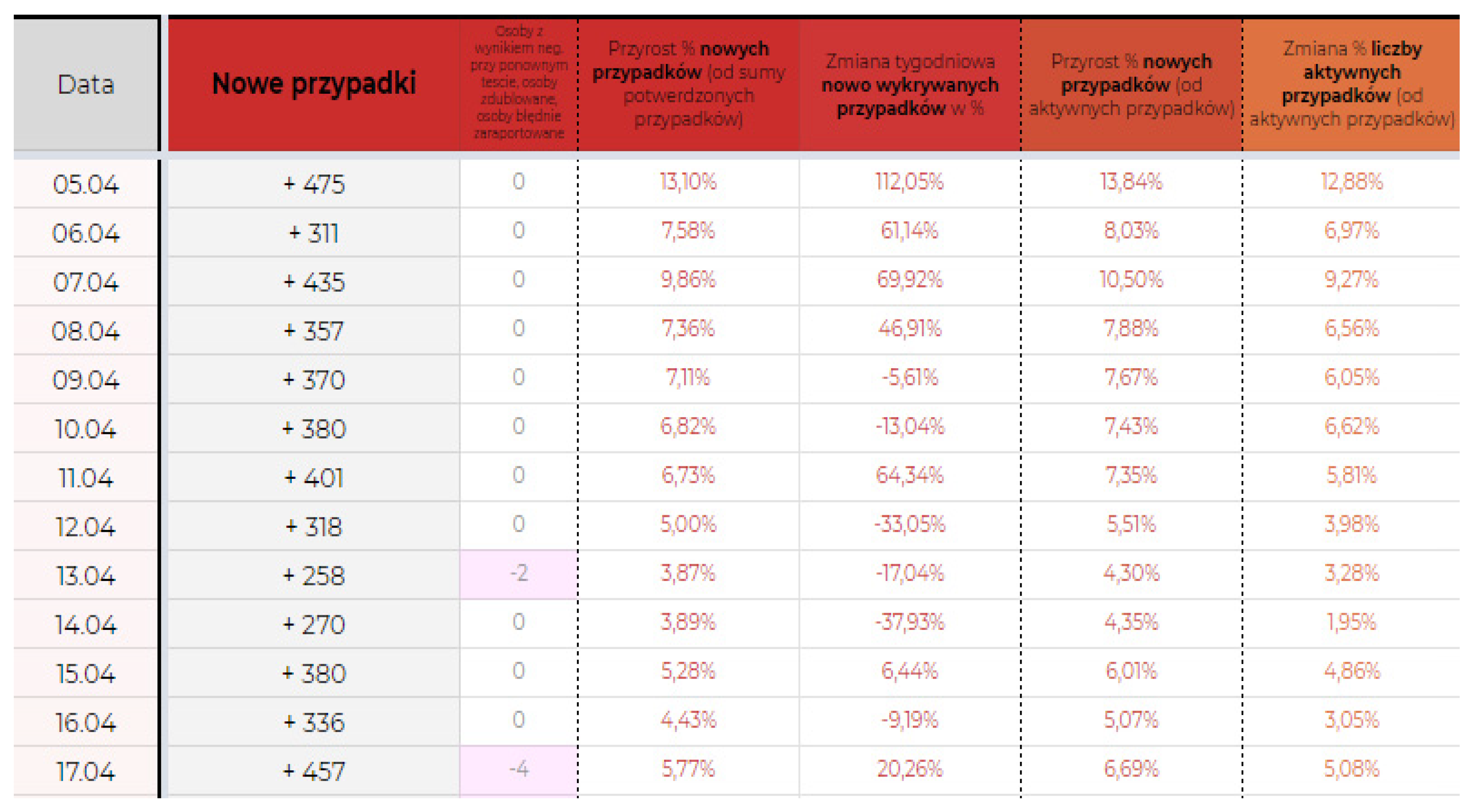
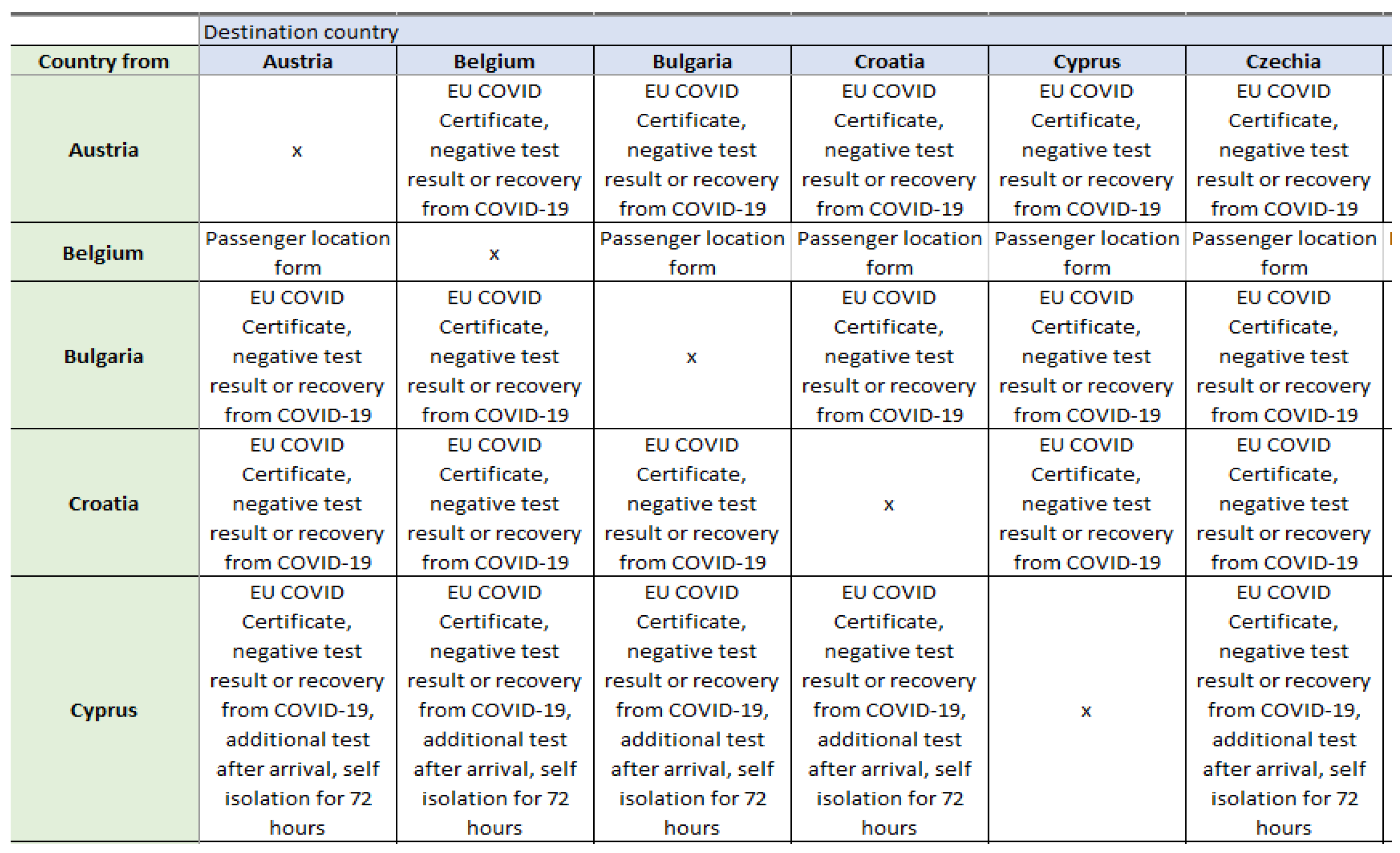
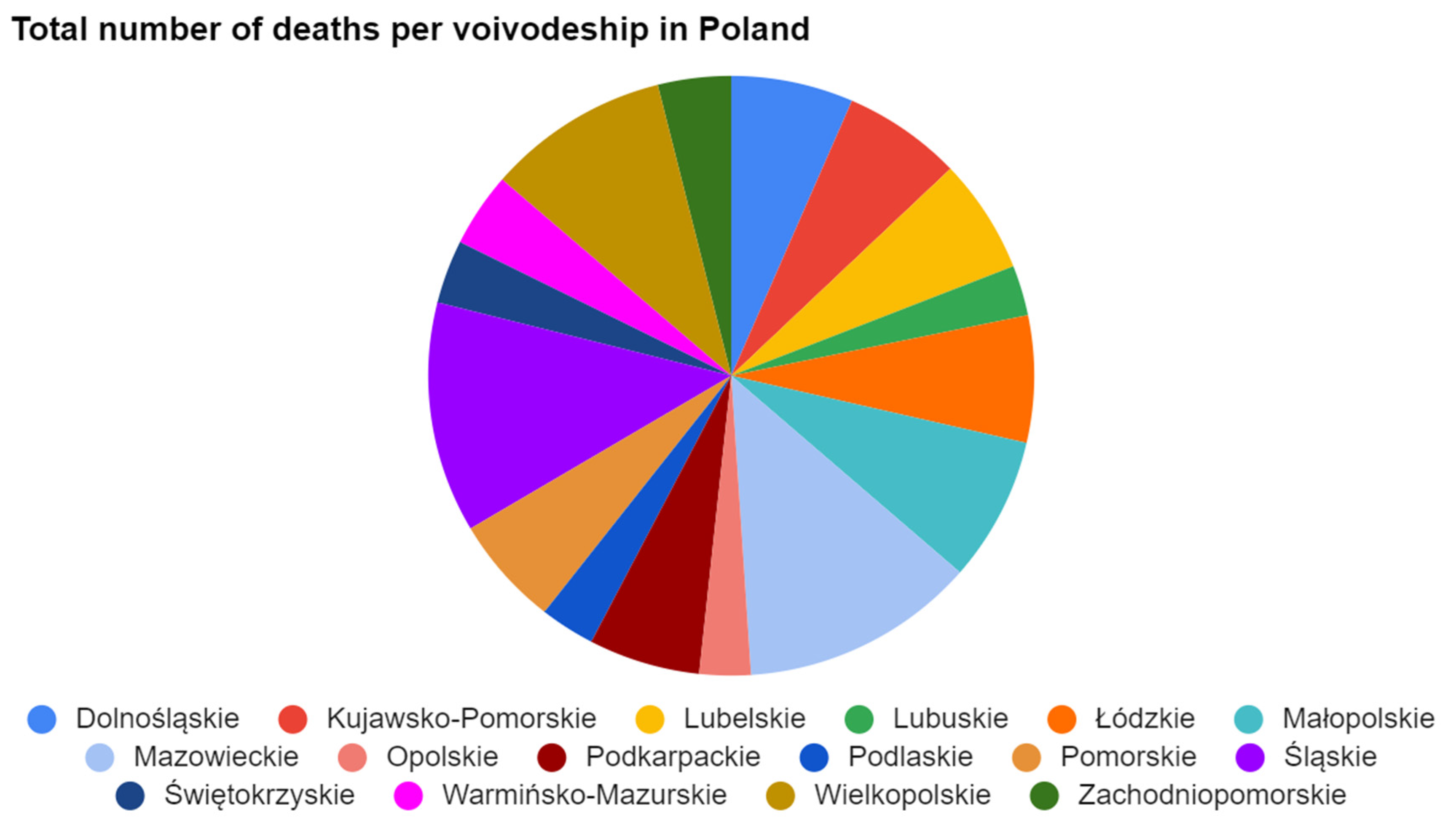

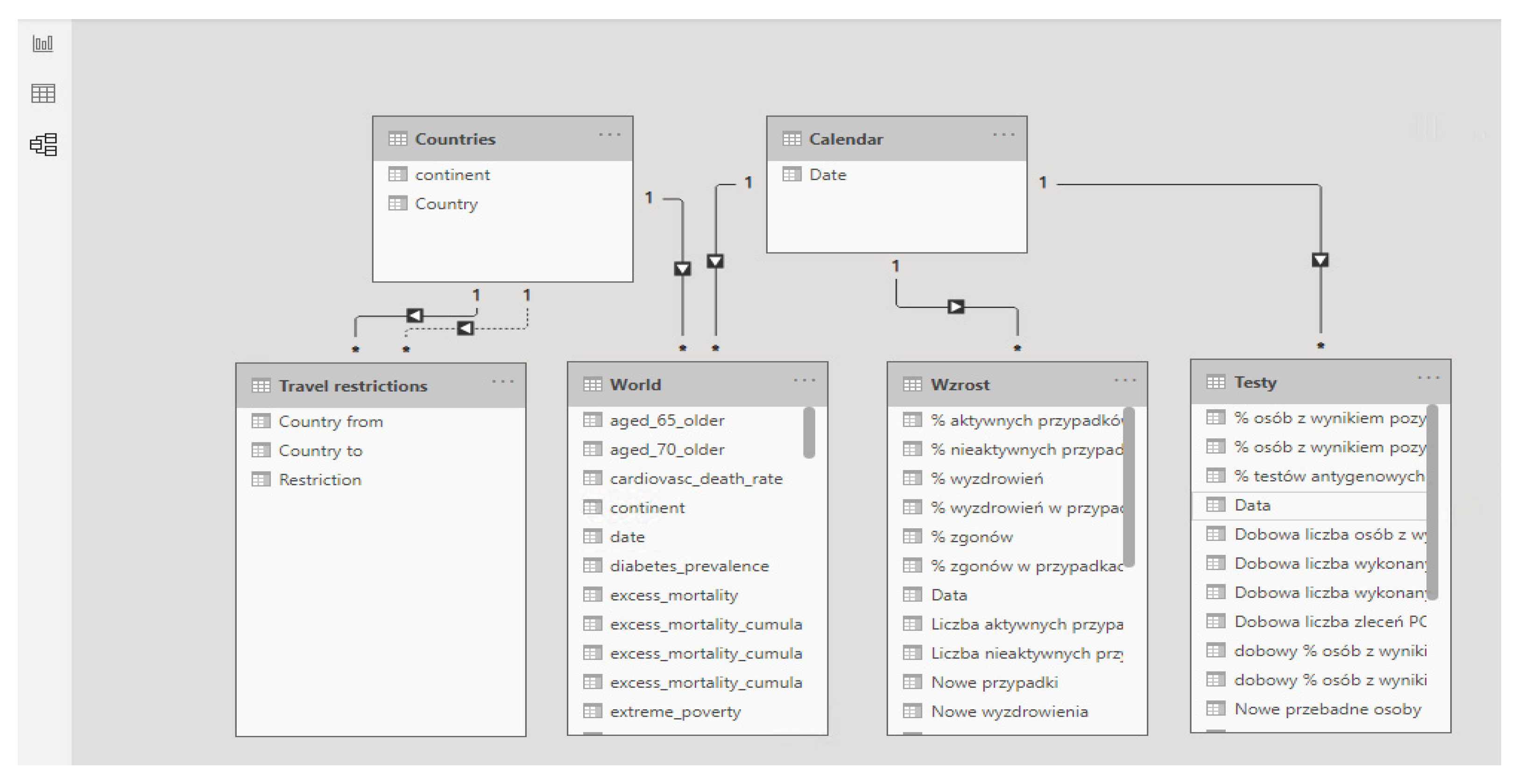
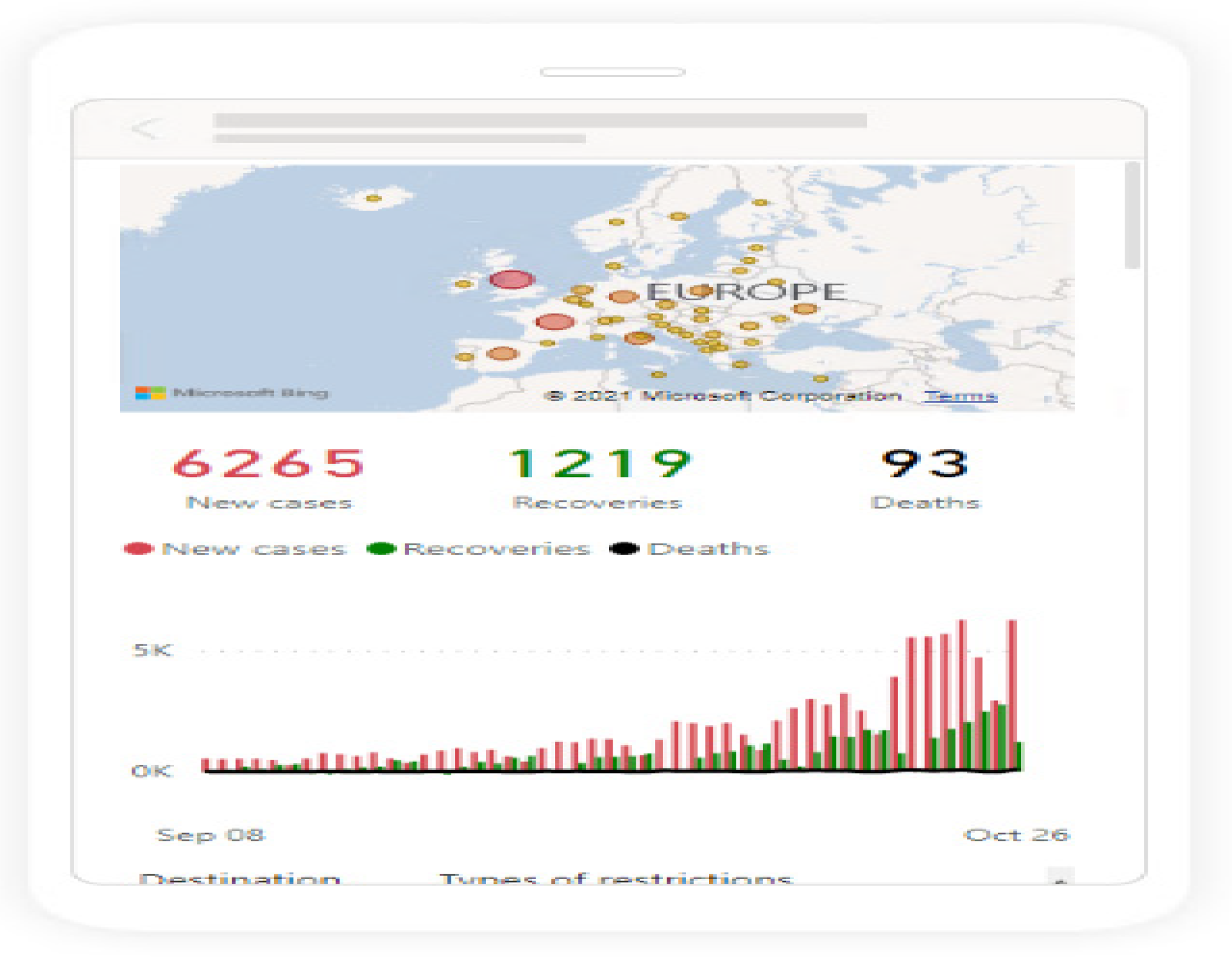
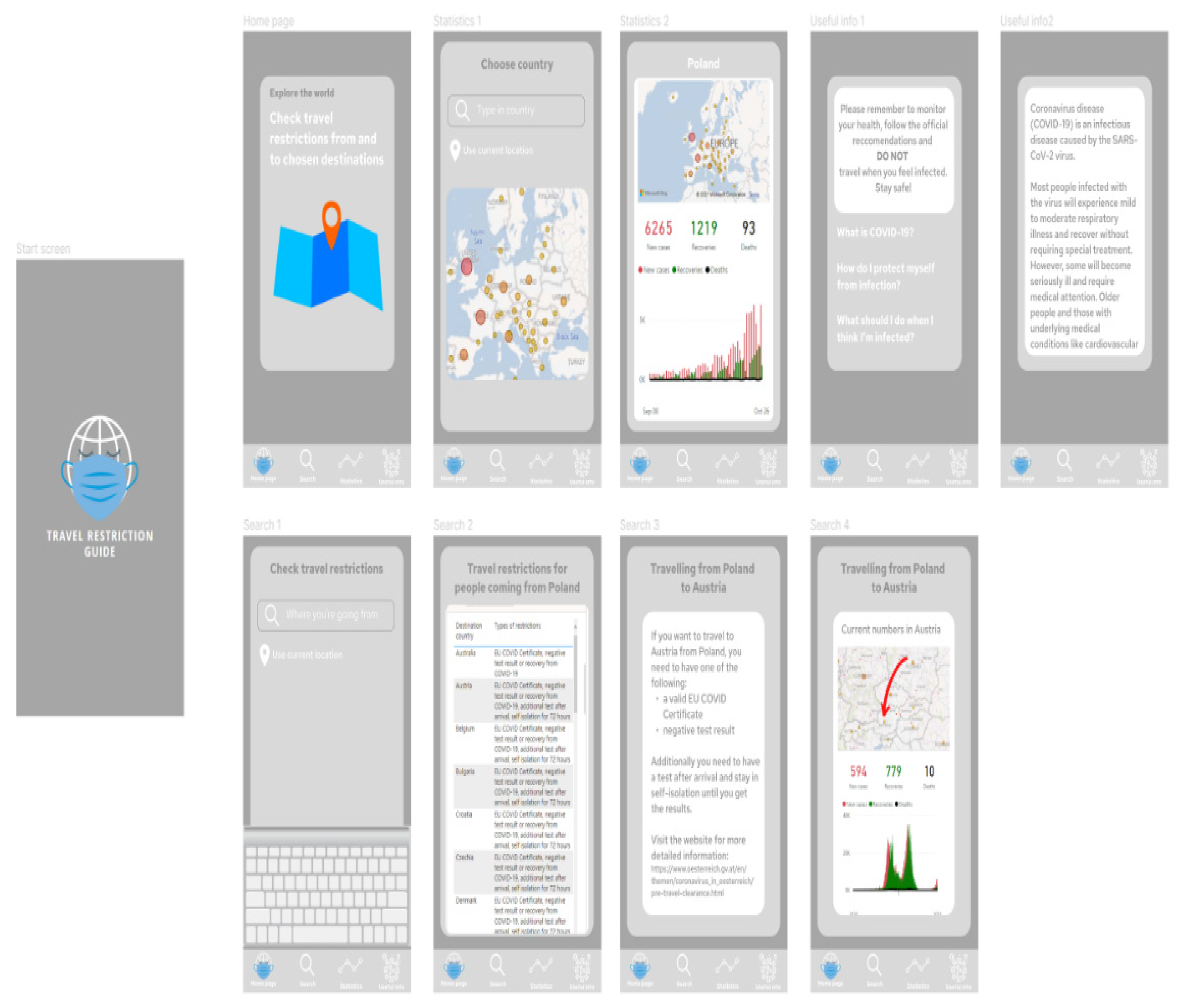
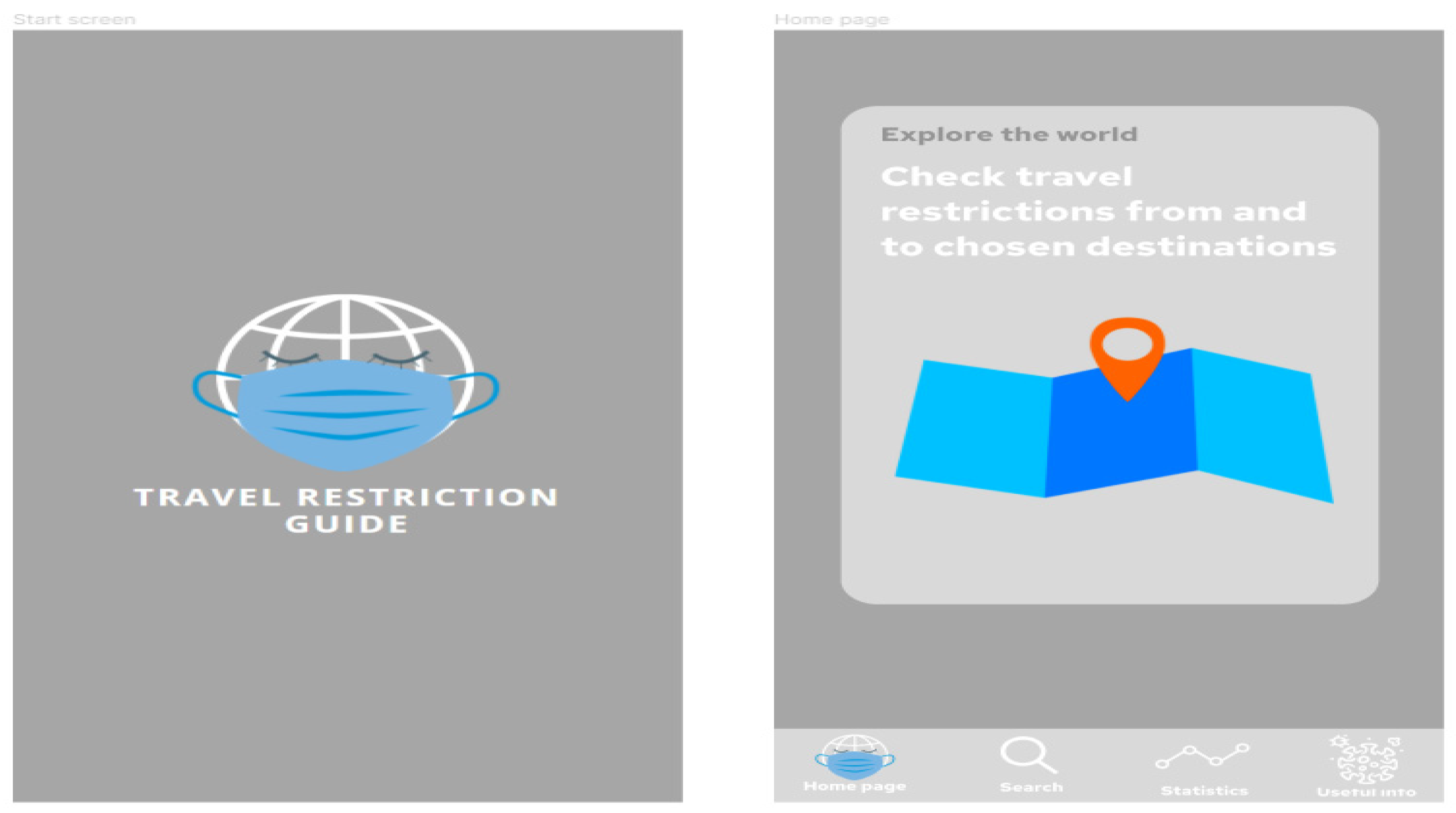


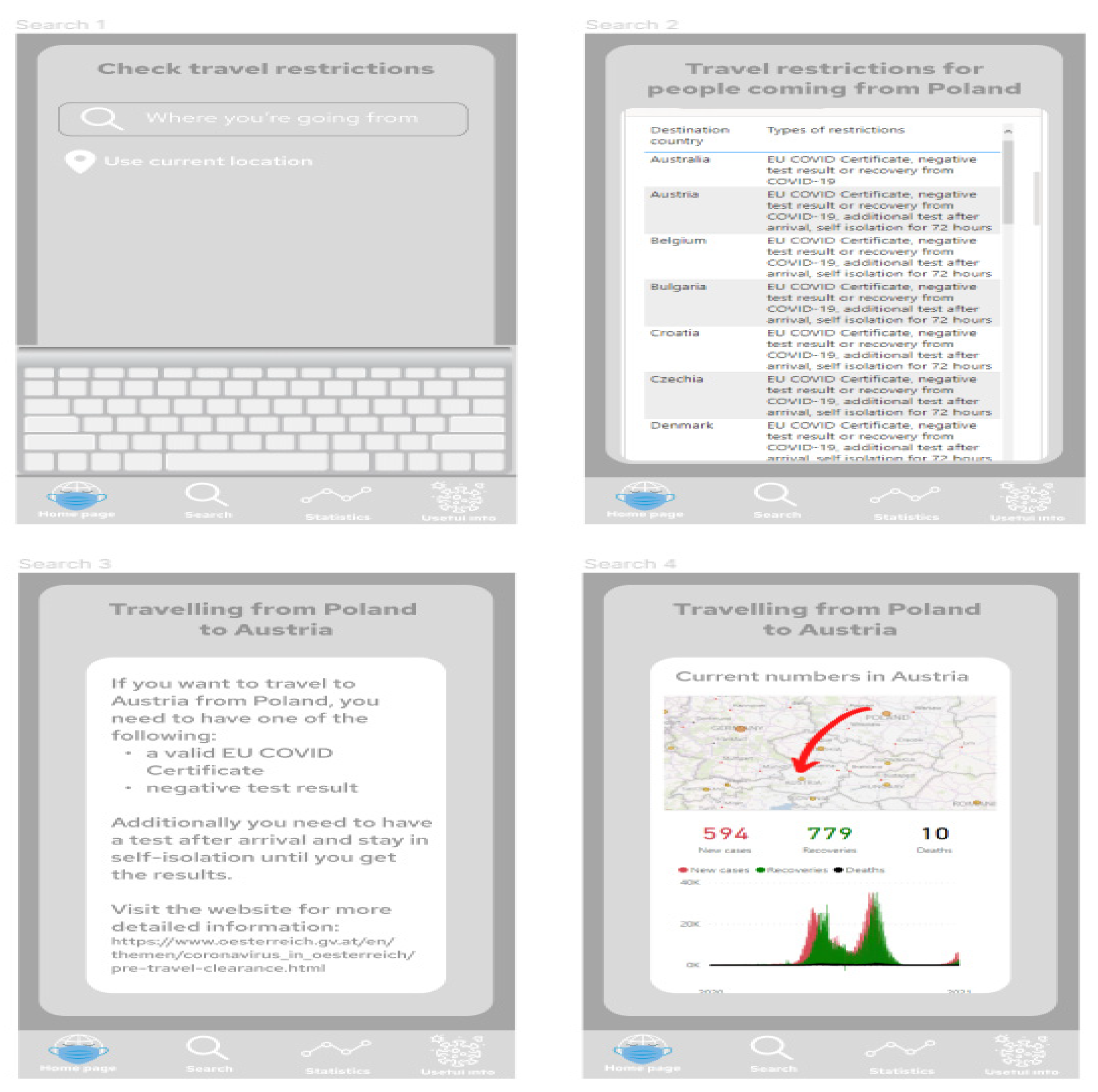
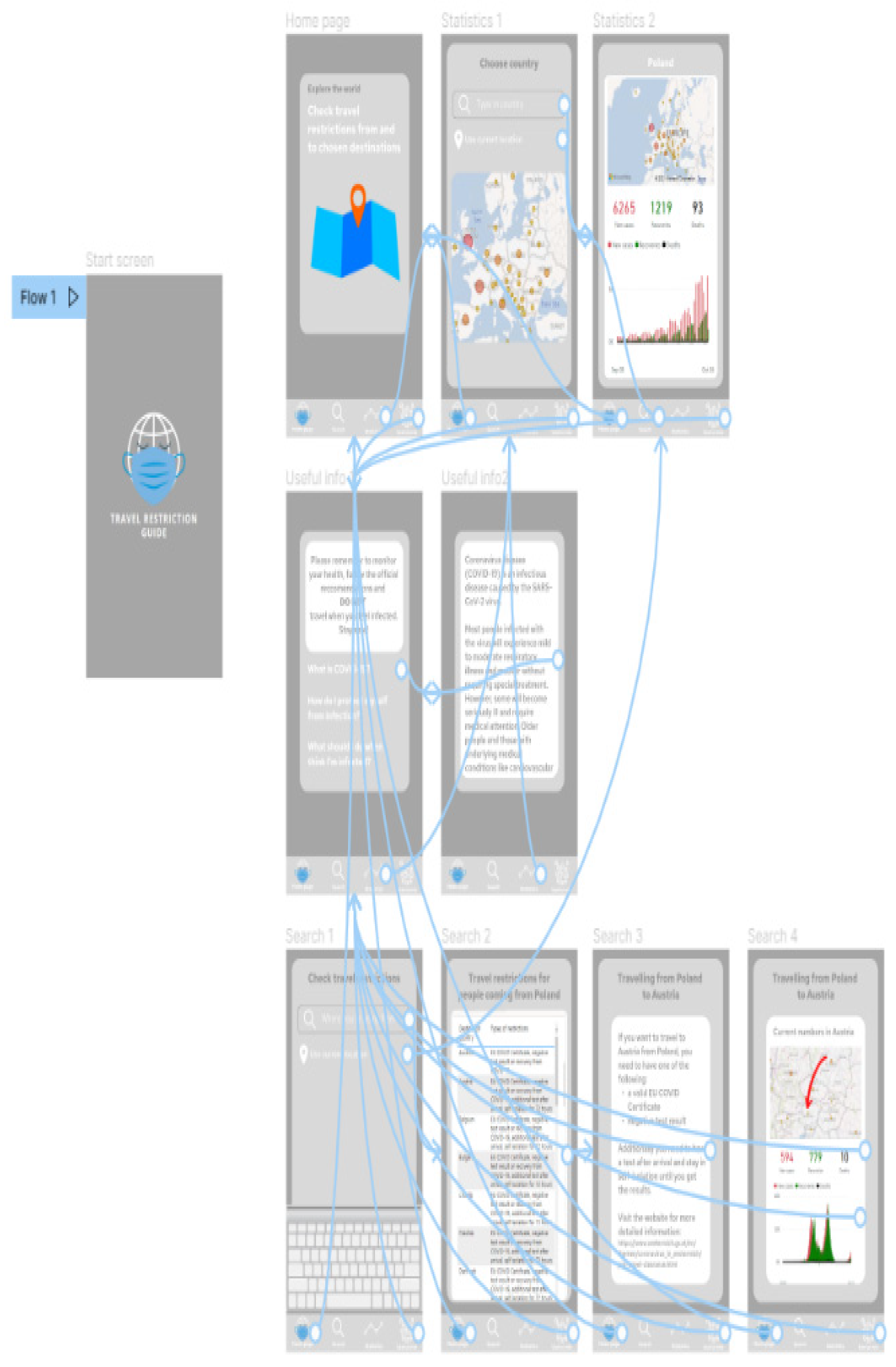
Publisher’s Note: MDPI stays neutral with regard to jurisdictional claims in published maps and institutional affiliations. |
© 2022 by the authors. Licensee MDPI, Basel, Switzerland. This article is an open access article distributed under the terms and conditions of the Creative Commons Attribution (CC BY) license (https://creativecommons.org/licenses/by/4.0/).
Share and Cite
Sawik, B.; Płonka, J. Project and Prototype of Mobile Application for Monitoring the Global COVID-19 Epidemiological Situation. Int. J. Environ. Res. Public Health 2022, 19, 1416. https://doi.org/10.3390/ijerph19031416
Sawik B, Płonka J. Project and Prototype of Mobile Application for Monitoring the Global COVID-19 Epidemiological Situation. International Journal of Environmental Research and Public Health. 2022; 19(3):1416. https://doi.org/10.3390/ijerph19031416
Chicago/Turabian StyleSawik, Bartosz, and Julia Płonka. 2022. "Project and Prototype of Mobile Application for Monitoring the Global COVID-19 Epidemiological Situation" International Journal of Environmental Research and Public Health 19, no. 3: 1416. https://doi.org/10.3390/ijerph19031416
APA StyleSawik, B., & Płonka, J. (2022). Project and Prototype of Mobile Application for Monitoring the Global COVID-19 Epidemiological Situation. International Journal of Environmental Research and Public Health, 19(3), 1416. https://doi.org/10.3390/ijerph19031416






